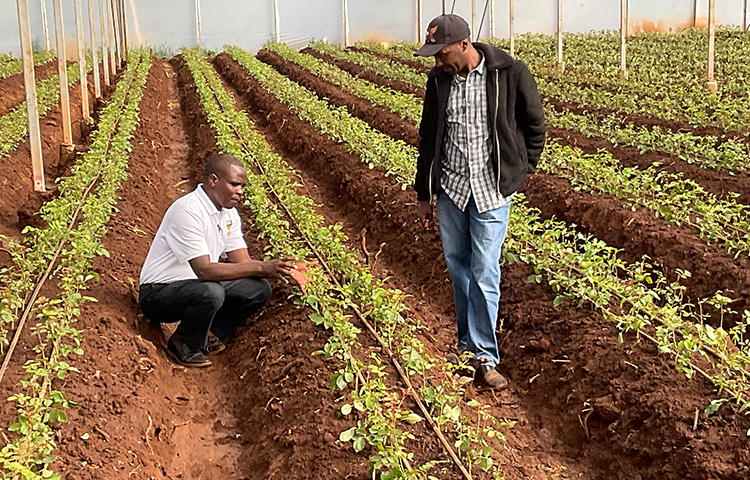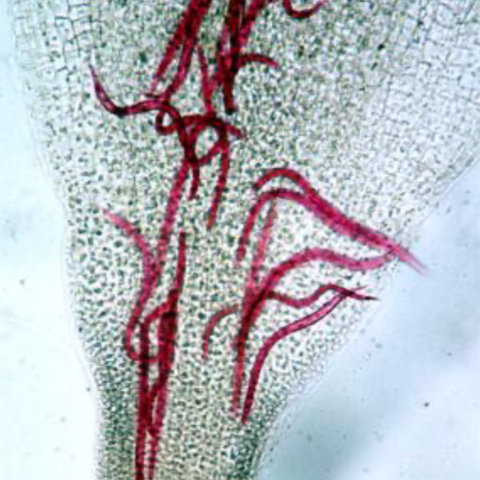Sustainable Approach to Nematodes Management
Plant parasitic nematodes (PPN) are one of the important and destructive pests in floriculture, attacking several varieties of cut flowers throughout the year. Plant parasitic nematodes cause direct and indirect damage leading to a decrease in yield, loss of quality, increased production cost, and reduced profitability. The cost of managing PPNs varies from region to region and is estimated to be between 7 % to 15 % of total crop production costs and up to 26% to 31% losses on some cut flower varieties. The losses are due to crop retardation, poor-quality unmarketable stems, and the death of plants due to opportunistic soil pathogens leading to higher disease severity and massive crop losses.
Growers are faced with difficult decisions due to limited active ingredients targeting nematodes, market restrictions on some active ingredients, and limited financial resources. This calls for a rapid and sustainable nematode management program. Accurate sampling and identification of nematodes, and proper intervention strategies with long-term outlook are the bedrock for good nematodes management in cut flowers. Throughout the growing cycle, growers are faced with different challenges which must be mitigated to ensure sustainable, optimal, and quality products to guarantee better returns on investments.

Newly planted roses in a greenhouse.
Effects of growing media on nematode infestation
Focusing on crop establishment and nematodes reminds us of a few critical points. Growing media (soil and hydroponics) is the cornerstone of productivity for all cut flowers - roses, hypericum, gypsophila, and carnations among others. Within the growing media are organisms, both beneficial and harmful which should be managed to enhance timely and proper crop establishment. Plant root interaction with some abiotic and biotic factors in the growing media may cause damage and losses. Nematodes prevalence is affected by edaphic factors including soil structure, soil pH, and soil temperature. Soil parasitic nematodes are the main pest that is critical at the early stage of crop establishment. Growing media preparation affects the proper establishment of the crop.
The occurrence, abundance, and frequency of Meloidogyne spp is more in sandy soils than clay soils. Favourable growing media conditions increase mobility, enhanced root penetration, and reproduction of nematodes (Dabire, Mateille, 2004). Soils that are well drained and with better macro porosity influence the population of plant parasitic nematodes (Avendano, Pierce, Schabenberger, Melakeberhan,2004). Does it imply that the frequency of nematode treatments in hydroponics systems is higher than in soil? This is a question for every grower.
Depending on growing media conditions, liming, fumigation, and composting are paramount to pests and disease management at this critical stage. Liming is carried out to adjust the soil pH. Fumigation is meant to reduce the parasitic soil organisms and composting is for general soil health improvement. Soils’ physical and morphological properties greatly determine nematode movement and crop damage. Combination of growing media particle sizes, porousness, and water content speed up the proliferation of nematodes due to better access to food source, mainly the plant roots.

Nematode types and sampling methods
Nematodes-infested plants appear stunted, less productive, and often show symptoms of chlorosis, wilting, and poor response to fertilizers, Parasitic nematodes are of two types: ectoparasitic and endoparasitic nematodes. Ectoparasitic nematodes, as the name suggests feed externally on plant tissues while endoparasitic nematodes feed within the tissues. The feeding relationship with the host plant guide the nematode sampling method. Ectoparasitic nematodes are mainly recovered from soil while endoparasites nematodes are detected in tissues in which they live and feed. The choice of nematicide is determined by the most prevalent type of nematode. Contact nematicides are more efficacious on ectoparasitic type while systemic nematicides are better in managing endoparasite nematodes.
Image: Endo parasitic nematode. (Source : www.syngentaornamentals.co.ke)
Common species of nematodes in cut flowers include Globodera pallida, Globodera rostochiensis, False root knot nematode (Nacohbus aberrans) which is highly polyphagous, Others are Pratylenchus spp, Meloidogyne hapla, Ditylenchus destructor, Ditylenchus dipsaci, and Xiphinema spp. Nematodes sampling is challenging compared to other pests because their presence is not easily visualized.
Sustainable Nematodes control methods
In the face of dwindling resources, pressure to reduce active ingredient load, restricted active ingredients, effects of global warming, and clamor for soil health, Stirling and Graham (2014) underscore the need for a sustainable Integrated Nematode Management program. Continuous improvement of soil structure by applying adequate organic amendments enhances soil fertility and aids in soil nematode management. Additionally, adoption of synthetic nematicides and biological agents are common practice that are effective in nematode control. In a cropping system general approach for the control of PPNs and other hidden soil pests:
- Is protecting the root system during the early stage of crop establishment and continuously monitor the crop for nematode infestations during the production cycle.
- Preventing of early season infection immediately after transplanting and
- In the case of post-planting treatment, the best timing is as soon as roots establish and at early detection of the parasites.
Several approaches are useful in implementing sustainable nematode management. Preventative approaches including sanitation and variety selection ensure early avoidance of the problem. Existing nematode populations in fields that have been cropped for long, may be attained through soil solarization, fallowing, and crop rotation. However, the application of these methods may be limited to annual cut flowers like lilies, hypericum, and eryngiums among others. The other disadvantage of these methods is they are effective for a short time.
Sanitation plays an important role in nematode management. Uncontrolled transfer of nematode-infested soils and plants or plant parts is a recipe for the spread of nematodes. It is advisable to only use nematode-free plants from reliable propagators. Irrigation water can be subjected to UV treatment and ultrafiltration before field application and subsequently before recycling. Tools and pieces of equipment used in nematode-infested places need a thorough cleaning before use in other areas to ensure zero introduction of PPNs to clean areas.
Nematode-suppressing plants are abundant in nature. Species such as sorghum, Sudan grass, and some species of marigold suppress PPNs. Such plants are effective when grown as solid, block planting for long time. Like with other cultural methods, nematode populations are bound to increase rapidly as soon as susceptible crop is re-introduced. A question that lingers in the mind of many growers is: how effective is intercropping nematode suppressive plants with the main crop in controlling nematodes?
Incorporating soil Amendments reduce the nematode effect on the crop. Such amendments including manure and composts increase the water and nutrient holding capacity of the soil leading to efficient extraction of nutrients and reducing the effect of PPN on the crop.
The use of novel synthetic and biological nematicides in a sustainable nematode management strategy cannot be overlooked. Incorporating and effectively alternating the various nematicide mode of action ensures growers have more sustainable solutions for nematode management. It should be noted that for nematicides to be effective the right dosage or chemical rate must be applied. Reducing the dose rate can lead to nematode insensitivity causing poor product performance. Alternatively, overdosing apart from being uneconomical and unsustainable may end up creating superbugs that do not respond to the right dose. The use of biocontrols is gaining more acceptance by ornamental growers as part of a sustainable PPN management strategy. It includes using pathogenic fungi that parasitize on PPNs.
Several fumigants and active ingredients have been used to control nematodes (https://www.syngentaornamentals.co.ke/blog/ornamentals-advisory-blog/ne…). Mostly, the application of nematicides on established crops is through drip and it is geared toward rapid reduction of high infestation. Chemigation, the use of a drip irrigation system to inject fertilizers and pesticides into the soil has several advantages:
- Rapid application of dissolved chemicals directly into the roots zones saves time,
- Is accurate and does not affect the foliage.
- Chemigation is not dependent on climatic conditions,
- Reduction of drift damage on open-door crops
- Saving work and reducing applicator exposure.
- Preventing external contamination of produce.
The activity of nematicides in soil depends on chemical adsorption and persistence. Adsorption is determined by the soil adsorption constant, Koc. A higher Koc indicates greater binding to soil particles and less availability. The frequency of nematicide applications during the crop life cycle is dependent on growing media, crop type, level of infestations, and irrigation water source.
The choice of nematicides is influenced by crop stage, product formulation, market requirements, and WHO classification. Granular products are best applied as pre-plant applications by spreading and incorporating into the growing media. Products containing abamectin with low Koc value are highly adsorbed within the soil particles hence less available for uptake by plant roots. To mitigate against soil adsorption Syngenta introduced a chelated abamectin, Tervigo.
Chelated with EDDHA NaFe, Tervigo is less binding and has better mobility into the crop roots reaching the targeted nematodes that burrow within the air roots. Tervigo is safe to plants and friendly to soil-beneficial organisms and due to EDDHA chelate, it enhances crop development.
Conclusion
With the issue of global warming, nematicides resistance management, nematicides accelerated microbial degradation, and the challenge of dwindling resources, cut-flower growers are faced with one challenge: growing more from less. An environmentally sustainable PPN (Plant Parasitic Nematodes) management strategy is achievable. The choice of growing media and soil types have a bearing affecting the mobility and availability of some active ingredients and this should be considered when making decisions on the nematicide choices. Although there are several alternatives in PPN management, no single method, on its own can be effective and sustainable in the long run. It’s important therefore to incorporate all nematode management methods including cultural practices, biocontrols and biological nematicides, and novel synthetic nematicides into a program for sustainable nematodes and crop management systems.
References:
1.Avendaño, F., F.J. Pierce, O. Schabenberger, and H. Melakeberhan (2004). Spatial variability. The spatial distribution of soybean cyst nematode in relation to soil texture and soil map unit. Agronomy Journal 96:181-194
2.Dabiré, R.K. and Mateille, T. (2004). Soil texture and irrigation influence the transport and development of Pasteuia penetrans, a bacterial parasite of root-knot nematodes. Soil Biology & Biochemistry 26, 539- 543.
3. Nishantha, K., Marasinghe, M., Wijethunga, H.M., Wijewardhane, K.G., Dissanayake, M., & Nugaliyadde, M.M. (2020). Soil Types and their Physio–Chemical Properties for Population Development of Root Knot Nematode (Meloidogyne spp.) in Tomato (Solanum lycopersicum).
4. Stirling, Graham R., (2014), Biological control of plant parasitic nematodes: soil ecosystem management in sustainable agriculture, 2nd Edition, CABI, UK.
5. Vieira P. & Gleason C. (2019). Plant-parasitic nematode effectors — insights into their diversity and new tools for their identification. Current Opinion in Plant Biology 50: 37-43